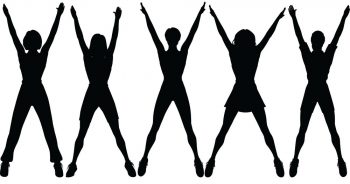by Gabrielle C. Durham
 I teach two kinds of group exercise classes, and part of the certification processes for both disciplines devoted no small amount of attention to how to speak to your minions, uh, students.
I teach two kinds of group exercise classes, and part of the certification processes for both disciplines devoted no small amount of attention to how to speak to your minions, uh, students.
- Negative forecasting is a no no. (Example: “Don’t think about the searing pain you’re probably feeling” is not considered positive forecasting.)
- Use the imperative rather than the interrogative. (Examples: “1, 2, 3, lift those legs behind your neck. Now!” vs. “Could you please move this way, pretty please?”)
- Try not to use overly involve anatomical terms, especially when referring to the butt. (Example: Use “seat” rather than almost any other term that all students would understand and potentially complain about. It’s happened.)
To be fair, the setting for such interactions matters. I teach in a gym, so word of mouth is terrifically important to getting bodies in the room, and you never know when you are going to offend someone with an offhand remark. At the studio where I also torture people for money, I have a bit more leeway with such rules. I’m still not supposed to say that a particular move will hurt or cause pain. Other rules include expectations such as: Don’t kill your client directly, try not to insult the client, come on time, wear clothing, et cetera.
Most dance classes, such as Zumba, NIA, Polynesian, or hip-hop, but not ballet, require almost no words, so that’s a factor that you can reasonably eliminate from this consideration of how language is used. If you can find the beat and see the instructor reasonably well, you can follow along as expertly as you can manage. When I took ballroom dancing, this was not the case, but the less said about that, the better.
Some classes emphasize the action of the movement less than in others. For example, in a restorative yoga class, the action described by the teacher might not use action verbs because that would detract from the goal of mindfulness for the student. In cardio-heavy classes, there is not as much verbiage. Why? The anaerobic quality of the class precludes much profound communication. A teacher in a spinning class (bicycle, not weaving) might use more inspirational/motivational you-can-do-it language. (“You’re almost there! Another minute at this level before we take it down a notch.”) Some people love that, and some do not (see point 3). That nonsense makes me wanna slay a Buffy with her headset, but that’s just me. Other students respond really well to the drill sergeant model. Again, not I.
Because a major focus is to motivate people to move safely, considerations of visual, auditory, or kinesthetic learners is less of a concern than it would be in a primary school classroom. I mostly teach adults, so learning styles matter less (ostensibly). That being said, I find that just saying the words (only satisfying auditory processing) results in more vacant looks and listless stillness than if I am also simultaneously demonstrating the desired exercise (both auditory and visual processing are in play).
Of course, many people go to the gym and have no interest in taking classes or even refuse to set foot in a place that advertises how it will make you sweat until you bleed. Some folks use apps and online videos to work out and have preferences for their preferred style of teacher. As we used to say in the late 90s, it’s all good. Regardless of how you feel when you are working out, chances are that there is some communication occurring at some level, even if it is a hard eyeroll after hearing an instructor tell you to breathe through your ribs as you hug your midline (guilty).
There’s the chipper quotient to contend with, which seems to be a prerequisite for every fitness teacher I’ve ever met. Perkiness is pretty much baked into teaching group exercise, although I’m not sure if that applies to male or male-identifying teachers as much as it does women. Overly cheerful is not my default setting, but I do teach with a sense of humor, which can smooth over some of my more glaring personality flaws.
In the classes I teach, I give cues throughout the practice to keep students safe and engaged. They tend to work up a sweat as we laugh and strive to lengthen the spine, work the abs, and feel joyful together for an hour a couple times a week. There’s not much that tops witnessing a student get into a pose correctly for the first time, to really “get” how it should feel. None of this is likely to compel you to check out a group exercise class if that’s not how you roll. As long as you’re not Prancercising, we’re cool.
